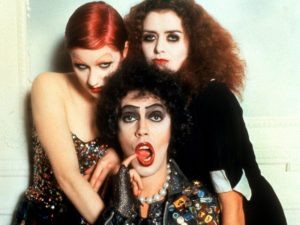At the time of its release, The Rocky Horror Picture Show (Jim Sharman, 1975, USA) was the epitome of Sontag’s depiction of Camp. The film thrives on the “gay sensibility”, as discussed by Babusico, by revolving around passionate characters who deviate from what is considered mainstream. The film has a ‘spirit of extravagance’ (Sontag 283) emulated through over-the-top mise-en-scene and performance. This is easily identified when looking at scenes like The Time Warp and Frank n Furter’s entrance thereafter. The Time Warp features hundreds of guests in uncoordinated outfits and accessories, performing an absurd ‘flash mob’. They are then interrupted by Columbia’s grand entrance, who tap-dances through the room in a flashy gold suit that beautifully compliments her bright red hair. After the song ends, the mob proceeds to fall onto the ground, leading to Frank n Furter’s entrance. Frank is the main character of Rocky, played by Tim Curry; they are the most camp of them all. The “Sweet Transvestite” only ever appears with a full face of drag makeup and is usually in a lacy black corset with pearls. Their outfit is the most ‘extra’ of all, and their gestures and speech patterns reaffirm their divergence from the stereotypical or normal. The Rocky Horror Picture Show works so well because it acknowledges its absurdity. It has the fantasy element of the characters being Aliens from the Planet of Transylvania and features characters who, at least in the beginning, are aware of the unnatural nature of these characters.

However, the point that stood out to me from the reading that has made me re-evaluate the film’s campness today is Sontag’s on the contextual nature of Camp (Sontag 280). The campness of a film relies on how it diverges from the norms of society, and as time goes on, these norms will evolve. The main things that could have been considered as Camp in 1975 when the film was released came out are now beginning to be normalized. While still heavily marginalized, gender fluidity is increasingly becoming more celebrated in younger generations, and while at the time this form of self-expression in the film was seen as camp, today it may not be as extraordinary.
The Rocky Horror Picture Show. (Jim Sharpman, 1975, USA)
Susan Sontag (1966), ‘Notes on Camp’, Against Interpretation and Other Essays (London: Penguin
Classics 2009).
Jack Babuscio (2004), ‘Camp and the gay sensibility, in Queer Cinema: The Film Reader (eds Harry M
Benshoff and Sean Griffin), New York: Routledge.
I am really intrigued by the idea you put forward about how what is subversive camp in one decade can be more adherent to the social conventions of a later time. Babuscio writes on page 124 about how the aestheticization of camp revolves around exotic and subjective fantasies. Expanding the point you raised, something that was foreign and exotic in the seventies, such as drag, now receives unquestionable mainstream attention in the form of RuPaul’s Drag Race.
I definitely agree that the gender fluidity and queer elements of the film no longer hold the same level of camp that they did in the 70s, but I think Rocky Horror still has a lot on offer in the way of camp. In particular, the dinner party scene breaks a ton of social rules through its cannibalistic nature, only to be superseded by a…. musical number? Like we just gloss over the fact that Dr. Scott just ate a bit of his nephew…